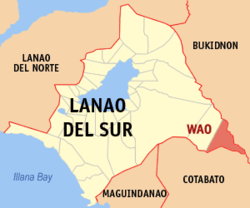Wao, Lanao del Sur
Wao | |
|---|---|
| Municipality of Wao | |
 Map of Lanao del Sur with Wao highlighted | |
Location within the Philippines | |
| Coordinates: 7°38′25″N 124°43′33″E / 7.640375°N 124.725733°E | |
| Country | |
| Region | Bangsamoro Autonomous Region in Muslim Mindanao |
| Province | Lanao del Sur |
| District | 1st District |
| Barangays | 26 |
| Government | |
| • Type | Sangguniang Bayan |
| • mayor of Wao[*] | Bobby Balicao |
| • Electorate | 40,630 voters (2022) |
| Area | |
| • Total | 485.24 km2 (187.35 sq mi) |
| Population (2020 census)[3] | |
| • Total | 50,366 |
| • Density | 100/km2 (270/sq mi) |
| Time zone | UTC+8 (PST) |
| ZIP code | 9716 |
| PSGC | |
| IDD : area code | +63 (0)63 |
| Income class | 2nd municipal income class |
| Revenue (₱) | ₱ 233.4 million (2020), 99.88 million (2012), 109.4 million (2013), 126.2 million (2014), 140.6 million (2015), 156.7 million (2016), 174.8 million (2017), 193.4 million (2018), 205.6 million (2019), 257.8 million (2021), 353.2 million (2022) |
| Native languages | Maranao Iranun Cebuano Tagalog |
| Website | www |
Wao, officially the Municipality of Wao, is a 2nd class municipality in the province of Lanao del Sur, Philippines. According to the 2020 census, it has a population of 50,366 people.[3]
It is the only municipality in the Philippines that begins with W.
Wao is also surrounded by Bumbaran in the north and west, Bukidnon in the east, and Cotabato to the south.
Barangays
Wao is politically subdivided into 26 barangays.
- Amoyong
- Balatin
- Banga
- Buntongun
- Bo-ot
- Cebuano Group
- Christian Village
- Eastern Wao (Poblacion)
- Extension (Poblacion)
- Gata
- Kabatangan
- Kadingilan
- Katutungan
- Kilikili East
- Kilikili West
- Malaigang
- Manila Group (Poblacion)
- Milaya
- Mimbuaya
- Muslim Village
- Pagalongan
- Panang
- Park Area
- Pilintangan
- Serran Village
- Western Wao (Poblacion)
History
The LASEDECO resettle program of then-President Ramon Magsaysay made possible the foundation of Wao as a municipality in Lanao del Sur province in January 19, 1954. The first settlers in the area were sixty (60) families of various ethnicity from the then-undivided Cotabato province. Only one person (Elvino B. Balicao, Sr) among the 1st batch of settlers became one of the Municipal Mayors of Wao. Mr Balicao, along with members of the 1st batch of 60 settlers that included the late couple Aludio & Sofia Emborgo, were welcomed by the native Muslim inhabitants of Wao led by Sultan Mamaco Saripada (the municipality's first appointed and elected mayor), Datu Tao Pagul and Datu Maki Saripada. They were treated to a sit-down meal in the house of Sultan Mamaco Saripada.[4]
Wao is a native place of Amai Mamco.
Demographics
| Year | Pop. | ±% p.a. |
|---|---|---|
| 1960 | 13,848 | — |
| 1970 | 16,577 | +1.81% |
| 1975 | 17,267 | +0.82% |
| 1980 | 15,962 | −1.56% |
| 1990 | 22,932 | +3.69% |
| 1995 | 27,503 | +3.46% |
| 2000 | 35,517 | +5.63% |
| 2007 | 42,186 | +2.40% |
| 2010 | 40,479 | −1.49% |
| 2015 | 45,862 | +2.41% |
| Source: Philippine Statistics Authority[5][6][7] | ||
Sister Cities
 Quezon City, Philippines[8]
Quezon City, Philippines[8]
References
- ^ Municipality of Wao | (DILG)
- ^ "Province: Lanao del Sur". PSGC Interactive. Quezon City, Philippines: Philippine Statistics Authority. Retrieved 12 November 2016.
- ^ a b Census of Population (2020). "Bangsamoro (BARMM)". Total Population by Province, City, Municipality and Barangay. Philippine Statistics Authority. Retrieved 8 July 2021.
- ^ Tales of Sofia Emborgo's early life in Wao by Evelyn E. Mills (aka Bebing of Wao)
- ^ Census of Population (2015). "ARMM – Autonomous Region in Muslim Mindanao". Total Population by Province, City, Municipality and Barangay. Philippine Statistics Authority. Retrieved 20 June 2016.
- ^ Census of Population and Housing (2010). "ARMM – Autonomous Region in Muslim Mindanao" (PDF). Total Population by Province, City, Municipality and Barangay. National Statistics Office. Retrieved 29 June 2016.
- ^ Censuses of Population (1903–2007). "ARMM – Autonomous Region in Muslim Mindanao". Table 1. Population Enumerated in Various Censuses by Province/Highly Urbanized City: 1903 to 2007. National Statistics Office.
- ^ "Sister Cities". Local Government of Quezon City. Retrieved 22 August 2016.
{{cite web}}: Italic or bold markup not allowed in:|publisher=(help)
External links
- Philippine Standard Geographic Code
- Local Governance Performance Management System
- Philippine Census Information

